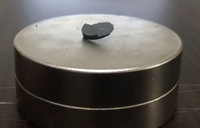
Photo from wikipedia
Abstract The thiosemicarbazones have exciting biological and nonlinear optical (NLO) applications. The present study reports detail experimental and computational studies of three novel ferrocene-substituted thiosemicarbazones: (E/Z)-4-benzyl-1-(1-ferrocenylethyl)thiosemicarbazones (1), (E/Z)-4-(4-chlorobenzyl)-1-(1-ferrocenyl-ethyl) thiosemicarbazone (2)… Click to show full abstract
Abstract The thiosemicarbazones have exciting biological and nonlinear optical (NLO) applications. The present study reports detail experimental and computational studies of three novel ferrocene-substituted thiosemicarbazones: (E/Z)-4-benzyl-1-(1-ferrocenylethyl)thiosemicarbazones (1), (E/Z)-4-(4-chlorobenzyl)-1-(1-ferrocenyl-ethyl) thiosemicarbazone (2) and (E/Z)-4-(2-bromo benzyl)-1-(1-ferrocenylethyl)thiosemicarbazone (3). These compounds were synthesized and resolved into their single crystal structures for the estimation of unit cells, space groups, bond angles and bond lengths. Chemical structures of 1–3 were further characterized spectroscopically employing nuclear magnetic resonance technique (1H NMR), infrared (FT-IR), mass and UV–Visible studies. Computational studies of 1–3 were performed using density functional theory (DFT) tools at M06 level of theory and 6–31 + G(d,p) basis set combination to gain the optimized geometry. A good correlation was found between experimental SC-XRD structures and DFT optimized geometries. Electronic properties including natural bond orbital (NBO) analysis, frontier molecular orbitals (FMOs) analysis, spectroscopic FT-IR data and NLO properties were calculated using same M06/6–31 + G(d,p) level of theory. NBO analysis confirmed the formation of charge separation state due to successful migration of electrons from donor to acceptor unit through π-bridge. Global reactivity parameters were estimated using energies of FMOs which described that 1–3 are chemically hard and stable molecules. Vertical electronic transition states were calculated using time-dependent DFT (TDDFT) at same level of theory. NLO properties of 1–3 were computed 5.77, 3.48 and 8.93 times greater than the standard urea molecule respectively. Two-state model confirmed the potential of synthesized molecules as NLO candidates.
Journal Title: Inorganica Chimica Acta
Year Published: 2019
Link to full text (if available)
Share on Social Media: Sign Up to like & get
recommendations!